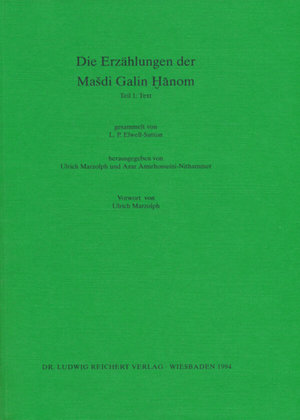
Die Erzählungen der Masdi Galin Hanom
Teil 1: Text
Der iranische Raum ist als Durchgangsgebiet auf der vermuteten Wanderung der Märchen und als jahrhundertealter Schmelztiegel kultureller Wertvorstellungen von besonderer Bedeutung für das Fachgebiet der vergleichenden Erzählforschung. Dennoch liegen bislang nur wenige zuverlässige Dokumente der mündlichen Erzählüberlieferung der Region vor, die sich heute ebenso wie die Traditionen benachbarter Regionen nur schwer gegen die modernen Kommunikationsmedien behaupten kann. Die hier veröffentlichten Erzählungen nach dem authentischen und weitestgehend unverfälschten mündlichen Vortrag einer alten persischen Kinderfrau stellen in mehrfacher Hinsicht ein einmaliges Dokument dar: Zum einen stammen die Märchen und Geschichten aus den 40er Jahren des 20. Jahrhunderts und wurden somit zu einer Zeit aufgezeichnet, bevor im Iran ein nennenswertes Interesse an Folklore und populäres Erzählgut entstand. Zum anderen stellen die Texte das weitaus größte publizierte Korpus einer einzigen Erzählerpersönlichkeit aus dem gesamten Vorderen Orient dar. Zum dritten schließlich wurden alle Texte ohne entscheiden Eingriffe nach der Niederschrift des Sammlers publiziert und bringen mit fast 500 Seiten in der schlichten und volkstümlichen Teheraner Umgangssprache das größte bislang veröffentlichte Textkorpus in persischer Umgangssprache überhaupt.
Abgesehen von diesen wissenschaftlich bedeutsamen Aspekten handelt es sich bei den von Mashdi Galin Khanom erzählten Märchen, Schwänken und Geschichten um ansprechend präsentierte, humorvolle und amüsant zu lesende Texte. Es sind keine Kunstmärchen mit der sprachlichen Raffinesse der klassischen persischen Romane, sondern bescheidene, unscheinbare aber nichtsdestoweniger wertvolle Kunstwerke einer begabten Erzählerin aus dem Volk. Sie sind besonders für den persischen Muttersprachler ein Lesevergnügen ersten Ranges, eignen sich darüber hinaus aber auch für den Einsatz im Sprachunterricht.
Der Textband enthält neben einem allgemein gehaltenen deutschen und persischen Vorwort sowie weiterführenden Literaturhinweisen die persischen Originaltexte der erzählten Geschichten sowie eine Erzählung. Der Begleitband enthält Bemerkungen zu den Kriterien der Textedition, sprachliche und inhaltliche Kommentare, ausführliche Dokumentation und Indices sowie die Gegenüberstellung verschiedener Fassungen in Umschrift.
Comparative research in folk narrative since long has been aware of the vital importance the Iranian cultural area bears in regard to the supposed international migration of narratives, itself sonstituting an ancient “melting pot” of cultural values of various origins. Even so, only very few reliable documents of the region’s oral narrative traditions have been published. This state is all the more deplorable since oral tradition has an increasingly difficult stand against modern media of mass communication. The narratives published here for the first time rely on the authentic and largely uncensored oral presentation of an illiterate old Iranian woman. The constitute a unique document in various respects: First, the tales and narratives originate from the 1940ies; thus were written down at a time when scientific interest in folklore and popular narrative was just beginning. Second, they comprise by far the largest narrative repertoire yet published told by an individual story-teller in any country of the Near East. Third, the publication has been prepared without any major changes directly from the collector’s manuscript, now comprising almost 500 pages of texts in the simple and unrefined Teheran vernacular of teh 1940ies; thus it presents the largest corpus of texts in the Persian vernacular ever published.
In addition to htese aspects relevant for scholarly research, Mashdi Galin’s tales and anecdotes are narrated in a fascinating and charmin manner, highly netertaining to read. There style is not the linguistic refinement of classical Persian literature, they rather constitute modest and unpretentious, nevertheless unique and extremely precious pieces of art. As such they are bound to fascinate the Persian native speaker and anyone interested in the Persian narrative tradition. Moreover, they constitute ideally appealing text material for Persian language tuition. Also, considering their wealth of folklorist details, they would offer themselves to be read by Iranians.
The publication is presented in two wolumes. The first volumes besides a general introduction in German and Persian as well as concise bibliographies contains the Persian texts of 117 narratives told by Mashdi Galin Khanom, supplemented by one story told by an Iranian journalist. The companian volume consists of notes on the criteria of editing the text, various commentaries on points of linguistic relevance and content, an extensive documentation listing narrative types, ans several indices. For purposes of demonstration, a juxtaposition of differing versions of two specific texts in transcription is appended.






